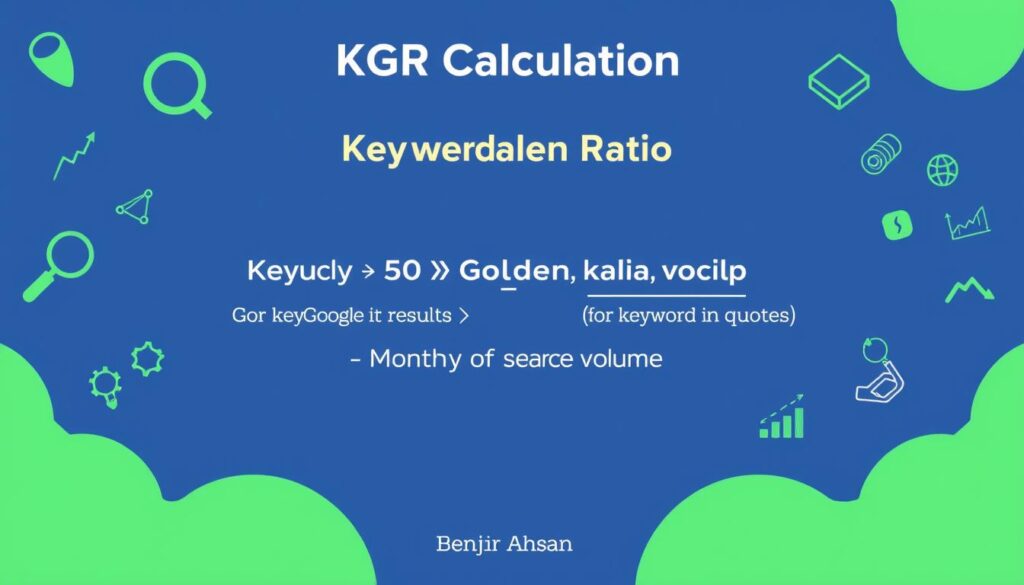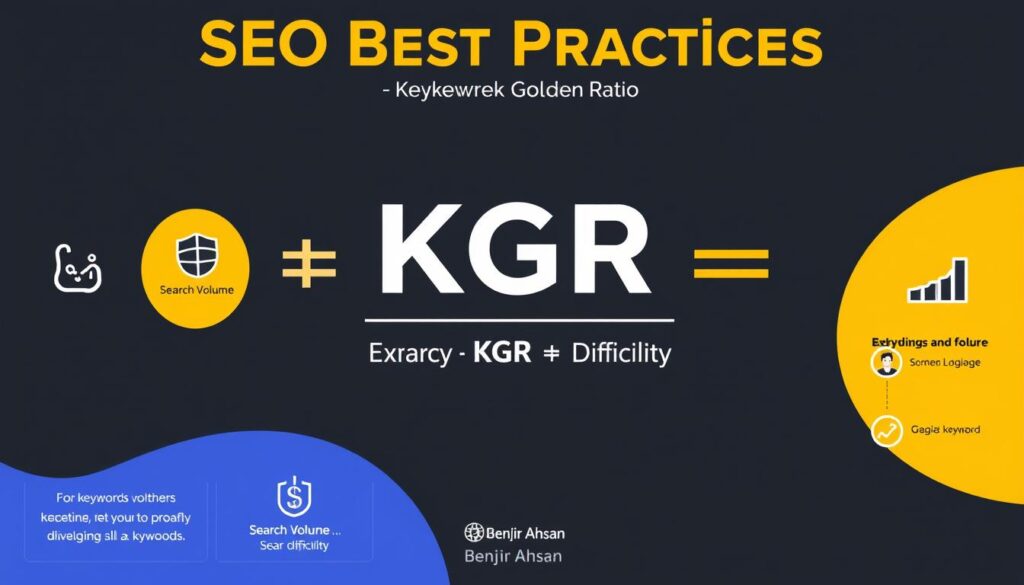It’s a shocking truth that 90.63% of web pages do not get any organic search traffic from Google. This highlights the importance of good keyword research. The Keyword Golden Ratio (KGR) is vital for SEO success. It helps you stand out in a crowded market. KGR is a key tool for anyone wanting to quickly improve their Google rankings. This guide explores how KGR plays a huge role in SEO.
Table of Contents
ToggleIt influences your position in search results and boosts organic traffic. These factors are essential for a strong marketing strategy. By combining expert advice, real-world examples, and SEO best practices, this guide shows you how to use KGR effectively. Learn to unlock its potential in your marketing efforts today.

The Importance of Keyword Golden Ratio in SEO Optimization
Key Takeaways
- Understanding KGR’s role in outpacing competition on SERPs.
- Using KGR for effective keyword research strategy.
- Incorporating KGR to enhance content marketing strategy.
- Adherence to SEO best practices for KGR application.
- Improving organic traffic through strategic KGR implementation.
The Importance of Keyword Golden Ratio in SEO Optimization
The Keyword Golden Ratio (KGR) is crucial for quick SEO improvements. It balances search volume and competition. This helps sites stand out on Google.
Understanding the Keyword Golden Ratio (KGR) and Its Impact on SEO
KGR makes finding underused, promising keywords easier. It looks at search terms versus exact match Google results. This method improves SEO by being both efficient and effective.
The Role of KGR in Improving SERP Ranking
KGR helps find specific, low-volume keywords. These keywords make climbing Google’s ranks easier. They reduce competition, helping sites move up faster.
How KGR Can Drive Organic Traffic to Your Site
KGR targets niche searches to draw in targeted traffic. It matches user intent, leading to more engagement and conversions. By focusing on specific queries, KGR makes SEO more precise and effective.
Conceptualizing the KGR Formula: A Comprehensive Breakdown
The Keyword Golden Ratio (KGR) is crucial for SEO success. It balances the need for online visibility with competition levels. By diving deep into KGR, marketers and content creators can enhance their strategies to stay ahead.
Analyzing the Components of the KGR Formula
KGR boils down keyword research to a simple formula. It measures how competitive a keyword is. It looks at how many search results have the keyword in the title and the keyword’s monthly searches, ideally below 250.
KGR Calculation Method and Its Significance in Keyword Research
To find the KGR, you divide the number of exact keyword titles in search results by the keyword’s monthly search count. A KGR below 0.25 is perfect. It shows a good mix of search interest and low competition.
| Keyword Example | Search Volume (per month) | SERPs with Exact Match in Title | Calculated KGR |
|---|---|---|---|
| organic gardening tips | 150 | 30 | 0.20 |
| easy home workouts | 110 | 12 | 0.11 |
| quick healthy recipes | 210 | 42 | 0.20 |
This strategy helps find less competitive niches. It lets brands draw in specific traffic that might be missed with lower search volumes.
Using the KGR formula enables smart, strategic decisions. This makes sure that digital marketing is seen and makes a difference in the competitive digital world.
Integrating Long-Tail Keywords into Your SEO Strategy
In the quest to boost online presence, long-tail keyword research is crucial. It’s key for a winning SEO strategy. Long-tail keywords address user’s specific questions. They greatly improve chances of turning visits to sales. Let’s explore how to effectively include long-tail keywords in your SEO efforts.
The power of long-tail keywords is in their precision. They match closely with what users search for. This accuracy not only makes your site more relevant but also attracts better quality traffic. These keywords face less competition. This makes them a prime choice for businesses looking to target niche markets.
| Keyword Type | Competitiveness | Potential for Conversion |
|---|---|---|
| Short-Tail | High | Lower |
| Long-Tail | Low | Higher |
Effective long-tail keyword research means knowing how your audience searches. Tools like Google’s Keyword Planner or Ahrefs are great for finding the best phrases. They help identify terms closely related to your offerings.
- Audience research: Pinpoint exactly who your customers are and how they express their needs in search queries.
- Competitive analysis: Evaluate the keyword strategies of competitors to spot opportunities they may have overlooked.
- SEO metrics: Gauge the performance of different keywords with respect to rankings, traffic, and conversions to continually refine your strategy.
Using long-tail keywords improves your SEO strategy. It not only increases visibility but also boosts user engagement. This means reaching more people and connecting with them on a deeper level.
Examining Search Volume and Keyword Ranking Correlation
The connection between search volume and keyword ranking is key to making a website more visible and successful in SEO. High search volumes suggest popularity, but too much competition can lower rankings. Meanwhile, keywords with lower search volumes can be goldmines. They can rank higher and bring in quality organic traffic with the right SEO tactics like the Keyword Golden Ratio (KGR).
Analyzing SEO keyword analysis in depth shows the tricky balance between search volume and rankings. It’s about knowing the challenges and opportunities with different keywords. For the best online presence, find the middle ground between popular keywords and those easier to rank for.
- High search volume keywords usually mean a lot of competition, making it tough to rank.
- Strategically chosen, lower volume keywords offer big chances to improve rankings and get targeted organic traffic.
- Effective SEO keyword analysis goes beyond volume to see if a high ranking is possible, considering the competition.
Making the most of this dynamic is central to strategic SEO planning. To illustrate, here’s some data with keyword examples, their search volumes, and rankings:
| Keyword | Search Volume | Keyword Ranking |
|---|---|---|
| Organic Gardening Tips | 1,900 | 15 |
| Easy DIY Projects | 2,400 | 27 |
| Healthy Quick Recipes | 800 | 5 |
The differences in search volume and keyword ranking shown highlight the importance of detailed keyword analysis. Moderately searched keywords can often rank high. They bring in valuable organic traffic likely to convert because searches are specific and relevant.

A truly successful SEO strategy focuses on drawing the right views with smart keyword choices and SEO keyword analysis. Understanding the search volume and keyword ranking correlation is not just technical. It’s a fundamental strategy.
Mastering the Art of Low Competition Keyword Research
Starting your SEO journey means finding low competition keywords. These are terms not many competitors use but can help you rank higher. They allow your business to be seen more easily.
Strategies for Finding High-Impact, Low Competition SEO Keywords
To discover the right keywords, mix intuition with smart tools. First, know your niche well. Then, use tools that show search trends and how hard keywords are to rank for. Choose keywords that many people search for but not many compete for. This is key for a successful SEO plan.
Optimizing for Low Competition Keywords: Techniques and Tools
Using these keywords means more than adding them to your content. Your whole SEO plan should adapt, including how you format content and optimize metadata. Tools like keyword analyzers make this easier. They help you adjust your site to be more relevant and authoritative.
| Tool | Function | Benefit |
|---|---|---|
| Keyword Explorer | Finds low competition keywords | Uncover hidden opportunities |
| SEO Management Platform | Integrates keywords into campaigns | Streamlines SEO operations |
| Content Analyzer | Checks keyword density and relevance | Optimizes on-page SEO |
By using these tools, companies can find niche keywords that others ignore. This method improves your online visibility. It also makes your content more engaging by being more relevant to your audience.
Adopting a Content Marketing Strategy Using KGR
When you use the Keyword Golden Ratio (KGR) in your content marketing, it helps you reach specific markets. It also makes your content easier to find on search engines. This method combines keywords, SEO strategies, and blog keyword planning. It ensures your content gets to the right audience and boosts search rankings.
Creating a Content Strategy for SEO with KGR
Using KGR in your SEO content strategy can make it more focused on what your audience likes. KGR looks at how often people search for things versus how much competition there is. It helps find keywords that a lot of people are interested in but not many sites use. This approach makes your content more appealing and valuable to users.
Aligning Blog Post Keyword Planning with KGR Principles
For better KGR results, it’s key to plan your blog posts around less competitive keywords. This makes it easier for your posts to rank faster in search results. Each post is a calculated step in improving your site’s SEO. They not only draw in readers but also move up quickly in rankings.

By using these strategies in your digital marketing, you can drive more focused traffic to your site. It greatly improves your site’s visibility and credibility. By concentrating on keyword efficiency and content that matters, companies can make smarter choices. These choices help increase organic growth.
Evaluating Keyword Difficulty Analysis for Better Ranking Decisions
Effective SEO strategies depend a lot on analyzing keyword difficulty. This means looking closely at the competition to get your website noticed. In this section, we’ll cover how to figure out keyword difficulty, competition, and value. This will help you make your SEO efforts as powerful as possible.
Understanding Keyword Competition and Keyword Effectiveness Index
Keyword competition shows the fight for the top spots using the same keywords. A lot of competition means it’s harder to rank well. But, if the competition is low and the keywords are good, you might find a great opportunity. Along with this, the Keyword Effectiveness Index (KEI) shows how useful a keyword could be. It looks at search volume and how many others are using it. A high KEI suggests a keyword that could be very valuable if targeted right.
Assessing Keyword Difficulty through SEO Keyword Analysis
To really understand keyword difficulty, you need to look at several things. Consider how often people search for it, how many are trying to rank for it, and how well they’re doing. This lets marketers see how hard it might be to do well with those terms. It’s all about figuring out where the best return on investment might be when choosing keywords to focus on.
| Keyword | Search Volume | Competitive Level | KEI Score |
|---|---|---|---|
| example keyword 1 | 1500 | High | 0.3 |
| example keyword 2 | 3000 | Medium | 0.7 |
| example keyword 3 | 800 | Low | 1.5 |
These numbers don’t just show the tough parts of keyword competition and keyword difficulty analysis. They also point out where there might be good chances to do well, based on a high Keyword Effectiveness Index. This helps lead to a smarter strategy for picking keywords.
Steps to Calculate the Keyword Golden Ratio for Your Content
Getting to grips with the kgr calculation method is key for content marketers aiming to up their SEO keyword optimization. This method zeroes in on finding valuable keywords to boost your site’s search engine ranks. Here’s a guide to calculating the Keyword Golden Ratio, making your keyword research and content planning more tactical.
- Identify Low-Volume Keywords: Start by picking keywords that get searched less than 250 times a month. This strategy targets less crowded niches.
- Count the Competing Pages: Look up the exact match keywords on Google. Count the results that have the keyword in the title tags directly.
- Calculate the KGR: Divide the number of pages competing by the monthly search volume of the keyword. Aim for a KGR under 0.25, indicating a strong chance for quick ranking gains.
Using the KGR formula gives you strategic insight into the competition versus search volume balance. Hitting below 0.25 in your KGR means you’ve found a sweet spot. It shows the keyword is ripe for targeting, with both reasonable competition and enough searches. Use this method to sharpen your SEO keyword optimization and develop a smarter SEO game plan.

Perfecting the kgr calculation method does more than streamline your keyword search. It significantly elevates your online visibility. This way, your content catches the eye of the right audience precisely when they’re looking.
Exploring Case Studies: Success Stories with KGR
The Keyword Golden Ratio (KGR) plays a key role in SEO success. It’s especially true for niche sites. They choose specific keywords to quickly rank, using low competition.
Real-World Examples of SEO Success with Keyword Golden Ratio
Using KGR strategies wisely leads to SEO victories. For instance, some niche sites quickly rose in Google rankings within months. They picked their keywords carefully, following KGR rules. This leap in rankings boosted their traffic and income.
How Niche Sites Benefit from Targeting KGR Keywords
Niche sites thrive by focusing on KGR. They avoid stiff competition by targeting specific, low-competition keywords. This strategy boosts their visibility and user engagement. It turns them into authority figures in their niches.
Small-scale sites often outshine bigger competitors with KGR. They become leaders and earn profits in their fields.
- Enhanced visibility for targeted and relevant searches
- Quicker ranking turnaround time compared to broader keywords
- Cost-effective marketing, yielding higher ROI from SEO investments
These real-life examples highlight how crucial KGR is for niche keywords. The right keyword strategy ensures long-term SEO triumphs.
SEO Best Practices for Integrating KGR into Your Website
Using the Keyword Golden Ratio (KGR) on your website means more than just adding keywords. It’s about placing them smartly to match both search engine requirements and what your readers want. This strategy helps your site not only climb the search rankings but also truly connect with your audience.
Keyword Density and Relevance in View of KGR
How often you use keywords matters, but you must be careful. Too many can lead to penalties for stuffing your content. The right amount makes your site visible without losing its natural tone. Beyond just adding keywords, it’s key to use ones that match what your audience is searching for. This way, your content stays relevant and interesting to users, which increases engagement.
Advanced SEO Keyword Optimization Strategies
Advanced SEO with a focus on KGR takes a careful, analytical look at how keywords perform. This means constantly checking how well your keywords do and adjusting your strategies to better connect with your audience. Using special tools and methods to deeply analyze keywords makes your content not just easy to find but also truly relevant.
Following top SEO practices and using KGR can really make a difference in where your site ranks. This approach not just spreads your content wider but also makes sure it hits the mark with users, answering their queries with exactly what they’re looking for.

| Strategy | Description | Impact |
|---|---|---|
| Keyword Density Optimization | Maintaining optimal keyword density without overstating | Prevents keyword stuffing, enhances readability |
| Relevance and Search Intent | Aligning keywords with user intent and search context | Improves user engagement and satisfaction |
| Continuous Performance Analysis | Regular analysis of keyword performance and content optimization | Enables timely updates and strategy shifts for better results |
Keyword Golden Ratio: Avoiding Common Mistakes and Misconceptions
Using the Keyword Golden Ratio (KGR) can really boost your SEO strategy. However, some common mistakes can hold you back. For instance, relying too much on KGR without looking at the whole SEO picture is an error. It’s a mistake to forget that high-quality content and a great user experience are key.
It’s wrong to only focus on optimizing for low competition keywords. This approach might make you choose keywords that don’t fit your content or interest your audience. A good long tail keywords strategy involves picking less competitive words that truly engage and benefit your audience.
To sidestep these mistakes, make sure adding keywords helps rather than hurts your content’s quality and appeal. We’ll show you how to better your keyword strategies while keeping your content engaging and relevant.
- Balance Between KGR Use and Content Quality: Never sacrifice content quality just to include certain keywords.
- User-Centric Keyword Integration: Think about what your audience is searching for, and make sure your keywords fit that context.
- Data-Driven Adjustments: Keep an eye on how your keywords perform and tweak your strategy based on facts.
| Common Mistake | Impact | Corrective Measure |
|---|---|---|
| Ignoring content quality for KGR | Reduces user engagement and satisfaction | Focus on high-quality, well-researched content |
| Misaligned keywords with user intent | Decreases conversion rates and increases bounce rates | Conduct thorough keyword and audience research |
| Not updating keywords based on performance data | Hampers ongoing SEO effectiveness | Implement regular reviews and updates to keyword strategy |
Following these tips helps you avoid common KGR errors. This way, your content will rank better in search results. Plus, it will truly help your audience.
Future of Keyword Research: Predicting the Evolution of KGR
The SEO world keeps changing, with Google search algorithm changes playing a key role. These changes impact how we find and use keywords. So, it’s important to look at what the future holds for the Keyword Golden Ratio (KGR), considering the ongoing SEO keyword research evolution.
Adapting to Changes in Google’s Search Algorithm with KGR
As Google gets better at figuring out what users want, KGR must adapt too. Updates aim to better grasp subtle searches. This requires a new way to research keywords. By blending SEO tactics with the latest updates, KGR can stay vital for marketers.
Gauging the Longevity of Keyword Golden Ratio as an SEO Technique
Will KGR stay useful in SEO? That depends on its ability to keep up with tech shifts and changing search habits. To keep KGR effective, we must constantly reassess and tweak strategies. This will help it remain strong in the competitive search game.
| Aspect | Impact on KGR | Future Relevance |
|---|---|---|
| Algorithm Complexity | Requires more refined KGR calculations | High |
| Search Behavior Changes | Needs updated KGR data sets | Moderate to High |
| SEO Tools Evolution | Integration with advanced analytics tools | High |
Conclusion
The journey through Keyword Golden Ratio (KGR) territory offers a clear path for digital marketers. It helps boost their SEO content strategy. By using the right keywords, websites can climb search engine rankings and attract more visitors. This guide highlights how KGR helps you stand out and find quick wins on search engine results pages.
Clearly, KGR fits perfectly into a strong SEO campaign. It shows the value of targeting less competitive keywords that people still search for. Using KGR can increase your website’s traffic and make it more visible online. This method relies on careful analysis of data and trends to be successful.
This guide outlines a clear SEO strategy that strengthens your content with the right tools and knowledge. By ranking well for specific keywords, your online success can grow steadily. As the internet changes, those who use KGR will lead in SEO. They turn keyword optimization into a science that helps businesses thrive online.
FAQ
What is the Keyword Golden Ratio (KGR) in SEO?
The Keyword Golden Ratio is a metric in SEO. It finds long-tail keywords with low competition and good search volume. To calculate it, divide the number of search results with the keyword in the title by the monthly search volume, when volumes are under 250. If the KGR is below 0.25, the keyword is easier to rank for.
Why is the Keyword Golden Ratio important for improving SERP ranking?
KGR helps creators and SEO pros find underused keywords with enough search intent. It can boost a website’s SERP ranking. By using these keywords, websites can rank faster and get more visibility.
How can utilizing the KGR drive organic traffic to my website?
Using the KGR can help your website climb the rankings quickly. It focuses on low-competition keywords that still get searches. This method leads to more targeted organic traffic and better engagement.
How is the KGR formula calculated, and why is it significant in keyword research?
To find the KGR, divide the number of search results featuring the keyword in the title by the monthly search volume. The volume should be less than 250. This ratio helps find keywords that aren’t too common and could rank faster.
What role do long-tail keywords play in SEO strategy?
Long-tail keywords are specific and longer. They’re vital in SEO because they target detailed user intent and can lead to more conversions. When they match the KGR, they greatly improve search rankings, especially for new or small sites.
How can the correlation between search volume and keyword ranking influence my content marketing strategy?
Understanding search volume and keyword ranking helps shape a successful content strategy. Using KGR-compliant keywords can make your content rank well. Even if these keywords have lower search volumes, they attract quality traffic.
What are the strategies for finding high-impact, low competition SEO keywords?
Strategies include doing thorough keyword research and analyzing your audience’s searches. Focus on niche terms. Then, use the KGR to find relevant, low-competition keywords for your audience.
How do I optimize for low competition keywords using KGR principles?
To optimize, create content that answers specific queries. Make sure the keyword density matches KGR principles. Always check how your keywords are doing and tweak your strategy to stay effective.
How do I align my blog post keyword planning with KGR?
Aligning your blog with the KGR means picking out keywords that fit the ratio. Then, craft content that answers those specific needs. This helps your content rank faster in search results.
What does understanding keyword competition and the Keyword Effectiveness Index (KEI) involve?
Understanding competition involves looking at who currently ranks for a keyword. The KEI compares search volume with competition level. These help figure out which keywords might be best to target.
How do I evaluate keyword difficulty in my SEO keyword analysis?
Evaluating keyword difficulty means looking at search volume, competition, and the authority of ranking pages. Tools and metrics like KEI can show how hard it may be to rank for specific keywords.
Can you provide steps on how to calculate the Keyword Golden Ratio for content?
For your content’s KGR: 1) Find keywords with less than 250 monthly searches. 2) See how many results have the keyword in the title. 3) Divide titled results by monthly search volume. If it’s below 0.25, it’s a good KGR target.
What are some real-world success stories with the use of the KGR?
Marketers and creators have seen big boosts in visibility by using the KGR. Niche sites, in particular, have fast-tracked their rankings. They’ve broken into markets more effectively by targeting KGR keywords.
How can I use KGR while ensuring adherence to SEO best practices?
To stick to SEO best practices with KGR, focus on quality content that meets searcher needs. Keep keyword density right without stuffing. Make sure your content is closely related to the KGR keywords you’re targeting.
What are common mistakes to avoid when using the Keyword Golden Ratio?
Common errors include chasing KGR keywords without caring about content quality or relevance. Don’t forget the importance of a good user experience. Tailor your keywords to fit your content and what your audience is looking for.
How should I adapt to changes in Google’s search algorithm using KGR?
Adapting to Google’s changes means staying current with SEO trends and guidelines. Keep refining your keyword choices. Be ready to adjust your strategies based on how well your KGR-targeted content is doing.
What is the future of KGR as a keyword research technique?
The future of KGR depends on how well it can adjust to changes in search and algorithm updates. Keeping the method effective will require constant re-evaluation and tweaks.




